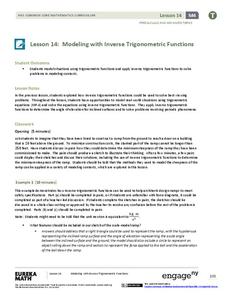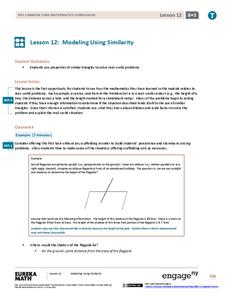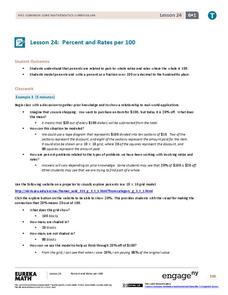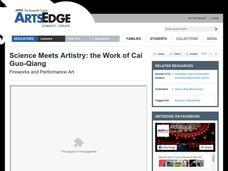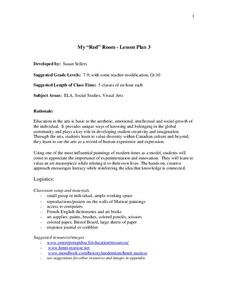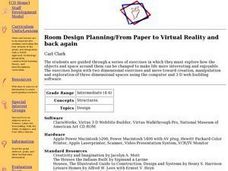Kids Yoga Stories
Valentine's Day - LOVE
Open your heart with a refreshing yoga session designed for Valentine's Day. With visual cues of hearts and other festive decorations, participants begin a series of yoga poses designed to open their heart chakras and to reflect on the...
Teach Engineering
Thinking Green!
Encourage your class to solve local environmental issues. Groups brainstorm environmental issues that are affecting the community, choose one they want to solve, and design a product or service to solve their chosen issue. They then...
Novelinks
Walk Two Moons: Guided Imagery
Sensory details can enhance the reading experience, especially during a guided imagery reading. Young readers close their eyes and listen to a passage from Sharon Creech's Walk Two Moons before responding to discussion questions and...
Teach Engineering
Design Step 3: Brainstorm Possible Solutions
Our young scientists have now specifically identified a problem, and this step helps them think of possible solutions. An outline, including guidelines, for brainstorming helps scholars stay on the right path. The resource includes...
EngageNY
Modeling with Inverse Trigonometric Functions 2
Use inverse trigonometric functions to work with ramps, rabbits, and Talladega. The class models real-world situations with trigonometric functions and solves them using inverses in the 15th installment of a 16-part series. Pupils solve...
EngageNY
Modeling Using Similarity
How do you find the lengths of items that cannot be directly measured? The 13th installment in a series of 16 has pupils use the similarity content learned in an earlier resource to solve real-world problems. Class members determine...
EngageNY
Modeling with Inverse Trigonometric Functions 1
Where should I stand to get the best view? Pupils use inverse trigonometric functions to determine the horizontal distance from an object to get the best view. They round out the lesson by interpreting their answers within context.
EngageNY
Determining the Equation of a Line Fit to Data
What makes a good best-fit line? In the 10th part of a 16-part module, scholars learn how to analyze trend lines to choose the best fit, and to write equations for best-fit lines to make predictions.
EngageNY
Average Rate of Change
Learners consider the rate of filling a cone in the 23rd installment of this lesson series. They analyze the volume of the cone at various heights and discover the rate of filling is not constant. The lesson ends with a discussion of...
Space Awareness
Make a Star Lantern
Go star-gazing with young learners! They study the history, origins, and patterns of constellations in an activity that explores the starry night sky.
EngageNY
Mixture Problems
What percent of the mixture is juice? Pairs use their knowledge of proportions to determine what percent a mixture is juice given the percent of juice in the components. Pupils use the procedure learned with the juice mixture problem to...
EngageNY
Percent and Rates per 100
What percentage of your class understands percents? Pupils learn the meaning of percents based upon rates per 100 in the 24th lesson in a series of 29. They represent percents as fractions, decimals, ratios, and models. The scholars...
EngageNY
The Structure of Ratio Tables—Additive and Multiplicative
Build tables by understanding their structure. Scholars take a closer look at the structure of ratio tables in the 10th segment in a 29-part series. Individuals realize that the tables can be built using an additive or multiplicative...
Scholastic
Tell Us a Tale: Teaching Students to Be Storytellers
Encourage scholars to retell their favorite short story or folktale, adding personal details to make it their own. After reading their book of choice several times, story tellers retell a tale verbally to their classmates.
NPR
Theatre Vocabulary
From actor to volume, the 90 terms on a theatre vocabulary list are must knows for any student of the dramatic arts.
Curated OER
A unicorn in the Snow
First graders compose own poetic sentences, using repetitive patterns, and carefully select sentenes with imagery. They make connections and see relationships and envision what might be. The poem is to be about an unexpected snowfall...
Curated OER
Science Meets Artistry: the Work of Cai Guo-Qiang
Students discuss and examine the work of artist Cai Guo-Qiang. In this art lesson, students analyze how cultural and historical factors impact the visual arts.
Curated OER
Represent Yourself
Students reflect on their strengths, to foster postive self-awareness and self-esteem. They discuss what the purpose of an adertisement is. What can an ad communicate? Students create an ad of themselves that reflects their own...
Curated OER
My "Red" Room
Students utilize art analysis skills by examining the work of Henri Matisse. In this painting lesson, students examine L'Atelier Rouge by Henri Matisse and identify the objects in the room and colors used. Students create their own rough...
Curated OER
The Envelope Please
Students examine and research the importance and functions of the skeletal system in vertebrates. They construct a 10-foot geodesic dome to illustrate the importance of architectural frameworks and create a clay animation movie.
Curated OER
Youth and Children
Students investigate the rights that students possess while examining human rights in relation to bullying. They develop ideas and advice for conflict resolution between students.
Curated OER
Room Design Planning/From Paper to Virtual Reality and Back Again
Students participate in activities in which they explore how the space and objects around them can be altered. Using various types of software, they design and create a three-dimensional building and share it with the class. They also...
Curated OER
A Sample Mini-lesson for Teaching Writing Conventions
Students study writing conventions. In this writing conventions lesson plan, students study writing they have already completed and look for conventions they are already using without realizing. In a small group, students discuss...
Curated OER
Moods, Feelings, Looks - Cross Out Puzzle Seven
In this ESL vocabulary worksheet, students write the mood, feeling, or look expression that best describes the 9 expressions. Students cross out the expression as they use them and read the 2-word phrase that is left.






